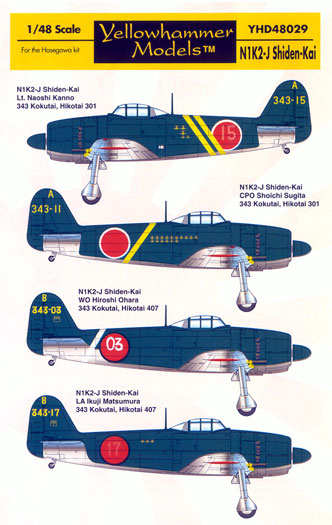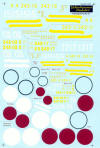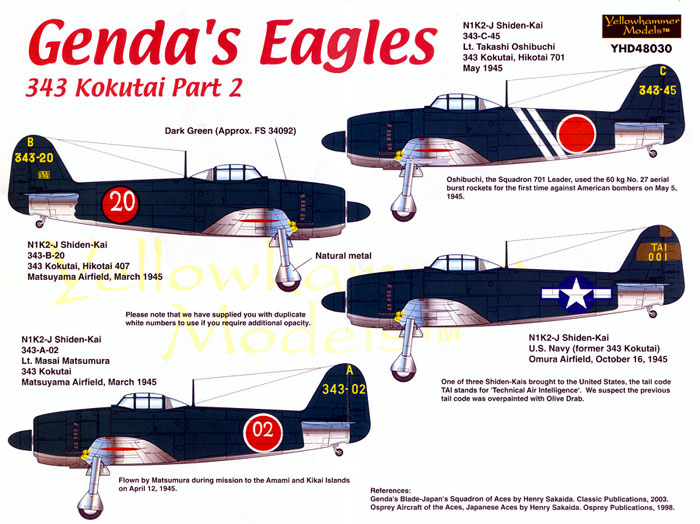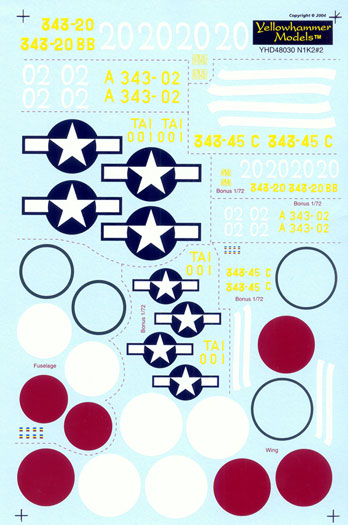S u m m a r y
|
| Catalogue
Number: |
Yellowhammer Models
YHD48029 and YHD48030 - GENDA'S EAGLES
343 Kokutai Parts 1 & 2 |
| Scale: |
1/48 (but also includes all
markings in 1/72) |
| Contents and Media: |
Double-sided colour
instructions plus notes sheet; 1 x full-size decal
sheet. |
| Price: |
each
USD$8.99 from
Meteor Productions website |
| Review Type: |
FirstLook |
| Advantages: |
Colour instructions with
plenty of diagrams; decals thin and in register; includes all
markings in 1/48 and 1/72 scales; double white markings supplied
where appropriate to ensure complete opacity; includes US
national markings for captured George |
| Disadvantages: |
no comprehensive stencil
data |
| Recommendation: |
Recommended |
Reviewed by Rodger Kelly

HyperScale is proudly sponsored by Meteor
Productions
Genda's Eagles from Yellowhammer Models is a
two-part issue covering the Kawanishi NiK2 J Shiden-Kai (George to
the Allies) of the Imperial Japanese Navy's 343rd Kokutai (air
group).
 YHD48029 YHD48029
The sheet covers four aircraft all of which are
in dark green over natural metal finish with dark green spinners and
yellow wing leading edge ID. The individual aircraft are:
-11, of the Hikotai 301 (301 Squadron) flown by
CPO Shoichi Sugita in April 1945. Supplied markings include:
- Yellow A squadron identifying letter
- Yellow 343-11 (eleventh aircraft of the
Hikotai 301, 343rd Air Group)
- Yellow Section Leader Band
- "Scoreboard" consisting of 16 kill
markings.
-17 of the Hikotai 407, flown by LT Ikuji
Matsumaura in March 1945. Supplied markings comprise:
- Yellow B squadron identifying letter
- Yellow 343-17 plane-in-squadron number
- "Scoreboard" consisting of 3 kill
markings.
- Four white 17s. These numbers were
painted on the fuselage hinomaru (national insignia) during
training and were removed prior to combat. Two sets are
provided for opaqueness.
- What appears to be a data plate stencil in
yellow for the vertical stabilizer.
-15 of the Hikotai 301, flown by LT Naoshi
Kanno from the Omura airfield in May, 1945. Markings comprise:
- Yellow A squadron identifying letter
- Yellow 343-15 plane-in-squadron number
- Twin yellow section commander stripes
- "Scoreboard" consisting of 5 kill
markings.
- Four white 15s for the fuselage hinomaru.
 -03
of the Hikotai 407, flown by WO Hiroshi Ohara in 1945. Markings
comprise: -03
of the Hikotai 407, flown by WO Hiroshi Ohara in 1945. Markings
comprise:
- Yellow B squadron identifying letter
- Yellow 343-03 plane-in-squadron number
- White section commander stripe.
- Four white 03s for the fuselage hinomaru.
- A data plate stencil in yellow for the
vertical stabilizer.
A single set of national markings are
provided. The white and green surrounds are supplied separately and
two sets of undercarriage oleo maintenance markings are also
supplied.
All of the markings are duplicated in 1/72
scale so in effect this is both a 1/72 scale sheet as well as a 1/48
scale one.
YHD48030
More of the same with this sheet, which also
supplies markings for four aircraft in dark green over natural metal
finish with dark green spinners and yellow wing leading edge ID.

The individual aircraft are:
-20 of the Hikotai 407, flown from Matsuyama
airfield in March 1945. No pilot's name given. Supplied markings
comprise:
- Yellow B squadron identifying letter
- Yellow 343-20 plane-in-squadron number
- Four white 20sfor the fuselage hinomaru.
- A yellow data plate stencil for the
vertical stabilizer.
-02 of the Hikotai 301, flown by LT Masai
Matsumaura from Matsuyama airfield in March 1945. Supplied markings
comprise:
- Yellow A squadron identifying letter
- Yellow 343-02 plane-in-squadron number
- Four white 02s for the fuselage hinomaru.
-45 of the Hikotai 701, flown by LT Takahashi
Oshibuchi in 1945. Supplied markings comprise:
- Yellow C squadron identifying letter
- Yellow 343-45 plane-in-squadron number
- Twin white section leader stripes for the
rear fuselage
 Finally,
the odd man out. TAI 001 which was one of the three Georges that
were captured and evaluated by the Technical Air Intelligence Unit
in the US. Markings comprise: Finally,
the odd man out. TAI 001 which was one of the three Georges that
were captured and evaluated by the Technical Air Intelligence Unit
in the US. Markings comprise:
- Yellow TAI 001 codes for the fin and
rudder
- A set of US stars and bars national
insignia. The placement guide shows that no US national
insignia was placed under the port wing but existing photographs
of these aircraft show that they were. Enough insignia is
supplied for you to do this though.
As with the previous sheet, all of the markings
are duplicated in 1/72 scale and there is a single set of hinomarus
with separate white and green borders.
The placement guides are the standard A4 sized
sheet folded in the centre. It shows colour profiles of each option
on the front cover and the same ones in a larger format in the
centre pages. The rear page shows a generic plan view.
The decals look to have been printed by
Microscale. They are thin, in register and there is a minimum of
decal film around each subject.
The placement guides and decal sheets are
packed in a clear plastic zip-loc bag.
A mixed bag. Whilst it is always great to get
excellent aftermarket sheets for Japanese subjects it is
disappointing to see that Yellowhammer have mixed both 1/72 and 1/48
scale on the same sheet. Perhaps it would have been better to issue
separate sheets in 1/72 and 1/48 scale. The extra space on the 1/48
scale sheet could have been put to better use in providing the
stencil data for the George that they had previously included on one
of their older George sheets – Y48-07 Hellcat Killers, that supplied
comprehensive stencil data.
Disregarding this, both sheets are still
recommended.
Footnote:
The placement guide advises that the dark
green used on the upper surfaces of these aircraft was an
approximate match for FS 34092.
To find out more about the colours used on
the George as well as other Japanese WWII aircraft visit Dave
Pluth's J-Aircraft.com at
http://www.j-aircraft.com/ Their FAQ section at
http://www.j-aircraft.com/faq/N1K.htm has a section on the
George as well as many other IJNAF aircraft.
Recommended.
Cutting Edge Modelworks products,
including Yellowhammer Decals, can be viewed at
Meteor Productions website
Review Copyright © 2004 by
Rodger Kelly
This Page Created on 19 May, 2004
Last updated
19 May, 2004
Back to
HyperScale Main Page Back to Reviews Page |
Home | What's
New | Features
| Gallery |
Reviews | Reference
| Forum
| Search